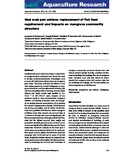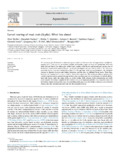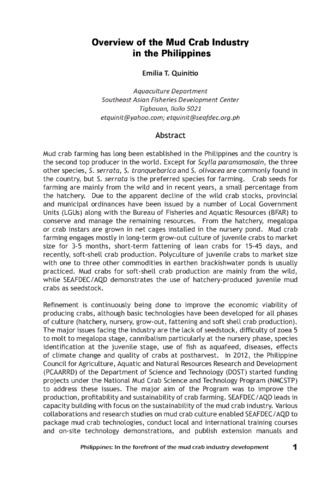Mud crab pen culture: replacement of fish feed requirement and impacts on mangrove community structure
- Global styles
- MLA
- Vancouver
- Elsevier - Harvard
- APA
- Help

View/
Date
2010Author
Page views
6,096ASFA keyword
AGROVOC keyword
Taxonomic term
Metadata
Show full item record
Share
Abstract
Brackishwater pond culture has been a major factor in mangrove loss in Southeast Asia, hence, the need to develop environment-friendly technologies such as mud crab Scylla (Portunidae) culture in mangrove pens exists. This study evaluated the effects of mud crab netpen systems in central Philippines on mangrove macroflora, and the replacement of dietary fish with low-cost pellets. Wild or hatchery-sourced Scylla olivacea and Scylla serrata were stocked at 0.5–0.8 m-2 in 167–200 m2 nylon netpens (2.3 cm stretched mesh) in Avicennia-dominated mangrove habitats. The feeding treatments were: (A) Zarraga: (1) no feeding (natural productivity), (2) no feeding for 1 month+supplementary feeding, (3) fish biomass and (4) low-cost pellets, and (B) Batan: (1) fish biomass and (2) pellets+fish biomass. Feeds were given ad libitum twice daily. Growth and survival rates of S. olivacea in Zarraga pens were not significantly different among treatments, although crabs fed fish biomass had the highest survival, body weight and production. Similarly, growth and survival of S. serrata were not significantly different between the Batan treatments. Economic analysis of the latter gave a 38.5% return on investment (ROI) and 2.6 years payback period (PP) for pellets+fish biomass treatment compared with 27.5% ROI and 3.6 years PP for fish alone. Sensitivity analysis showed an improved economic performance of the pellets+fish biomass treatment by increasing the survival rate. Evaluation of mangrove community structure showed that crab culture reduced species diversity, numbers and biomass of seedlings and saplings, but not of mangrove trees. Therefore, mud crab pen culture is recommended for mangrove sites with mature trees, but not seedlings and saplings, and low-cost pellets can reduce dependence on fish biomass.
Suggested Citation
Primavera, J., Binas, J. B., Samonte-Tan, G. P. B., Lebata, M. J. J., Alava, V. R., Walton, M., & LeVay, L. (2010). Mud crab pen culture: replacement of fish feed requirement and impacts on mangrove community structure. Aquaculture Research , 41(8), 1211-1220. https://doi.org/10.1111/j.1365-2109.2009.02408.x
Type
ArticleISSN
1365-2109Collections
- Journal Articles [1258]
Related items
Showing items related by title, author, creator and subject.
-
Larval rearing of mud crab (Scylla): What lies ahead
Waiho, Khor; Fazhan, Hanafiah; Quinitio, Emilia T. ; Baylon, Juliana C.; Fujaya, Yushinta; Azmie, Ghazali; Wu, Qingyang; Shi, Xi; Ikhwanuddin, Mhd; Ma, Hongyu (Elsevier, 2018)
The increasing global demand for mud crabs (genus Scylla) and threats to the wild populations highlight the urgency of fully rearing them in captivity. Despite considerable progress in mud crab production, most crab farms ...
; Baylon, Juliana C.; Fujaya, Yushinta; Azmie, Ghazali; Wu, Qingyang; Shi, Xi; Ikhwanuddin, Mhd; Ma, Hongyu (Elsevier, 2018)
The increasing global demand for mud crabs (genus Scylla) and threats to the wild populations highlight the urgency of fully rearing them in captivity. Despite considerable progress in mud crab production, most crab farms ... -
Mud crab pond and pen culture
Rodriguez, Eduard M. (University of the Philippines Aquaculture Society, Inc, 2001) -
Overview of the mud crab industry in the Philippines
Mud crab farming has long been established in the Philippines and the country is the second top producer in the world. Except for Scylla paramamosain, the three other species, S. serrata, S. tranquebarica and S. olivacea ...




